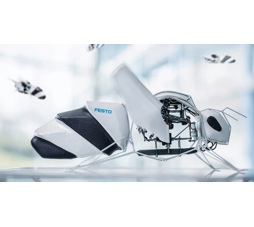| A Swarming Bee From Festo |
| Written by Lucy Black | |||
| Sunday, 12 May 2024 | |||
|
The latest addition to the Festo Bionic Learning Network menagerie of bionic robots inspired by the natural world is a bee. Like the Bionic Ant from a decade ago, it has been designed not only look realistic but to demonstrate swarm intelligence.
Since the 1990s, German automation company, Festo has been working with bionics robots to: "motivate, inspire, enthuse and kick-start innovation". Its international Bionic Learning Network was formed in 2006, linking Festo to roboticists in universities, institutes, development companies, and to private inventors, and every year the latest technology is presented at the annual Hannover Messe Exhibition. At around 34 grams in weight, a length of 220 millimetres and a wingspan of 240 millimetres, the BionicBee which made its debut in April at the Hannover Messe 2024 is the smallest flying object created by the Bionic Learning Network to date. It is also the first flying object created by the Bionic Learning Network that can fly in large numbers and completely autonomously in a swarm. Another innovation is that for the first time, the developers used the method of generative design: after entering just a few parameters, a software application uses defined design principles to find the optimal structure to use as little material as necessary while maintaining the most stable construction possible. This consistent lightweight construction is essential for good manoeuvrability and flying time. The autonomous behavior of the bee swarm is achieved with the help of an indoor locating system with ultra-wideband (UWB) technology. For this purpose, eight UWB anchors are installed in the space on two levels. This enables an accurate time measurement and allows the bees to locate themselves in the space. The UWB anchors send signals to the individual bees, which can independently measure the distances to the respective transmitting elements and calculate their own position in the space using the time stamps. To fly in a swarm, the bees follow the paths specified by a central computer. To ensure safe and collision-free flight in close formation, a high degree of spatial and temporal accuracy is required. When planning the path, the possible mutual interaction through air turbulence “downwash” must also be taken into account. As every bee is handmade and even the smallest manufacturing differences can influence its flight behavior, the bees additionally have an automatic calibration function. After a short test flight, each bee determines its individually optimized controller parameters. The intelligent algorithm can thus calculate the hardware differences between the individual bees, allowing the entire swarm to be controlled from outside, as if all bees were identical. More InformationRelated ArticlesIs It A bird? No It's A Festo Robot Festo's BionicSoftArm and Hand Festo's Flying Fox And Spider Robots Are Worth Seeing To be informed about new articles on I Programmer, sign up for our weekly newsletter, subscribe to the RSS feed and follow us on Twitter, Facebook or Linkedin.
Comments
or email your comment to: comments@i-programmer.info |
|||
| Last Updated ( Sunday, 12 May 2024 ) |




